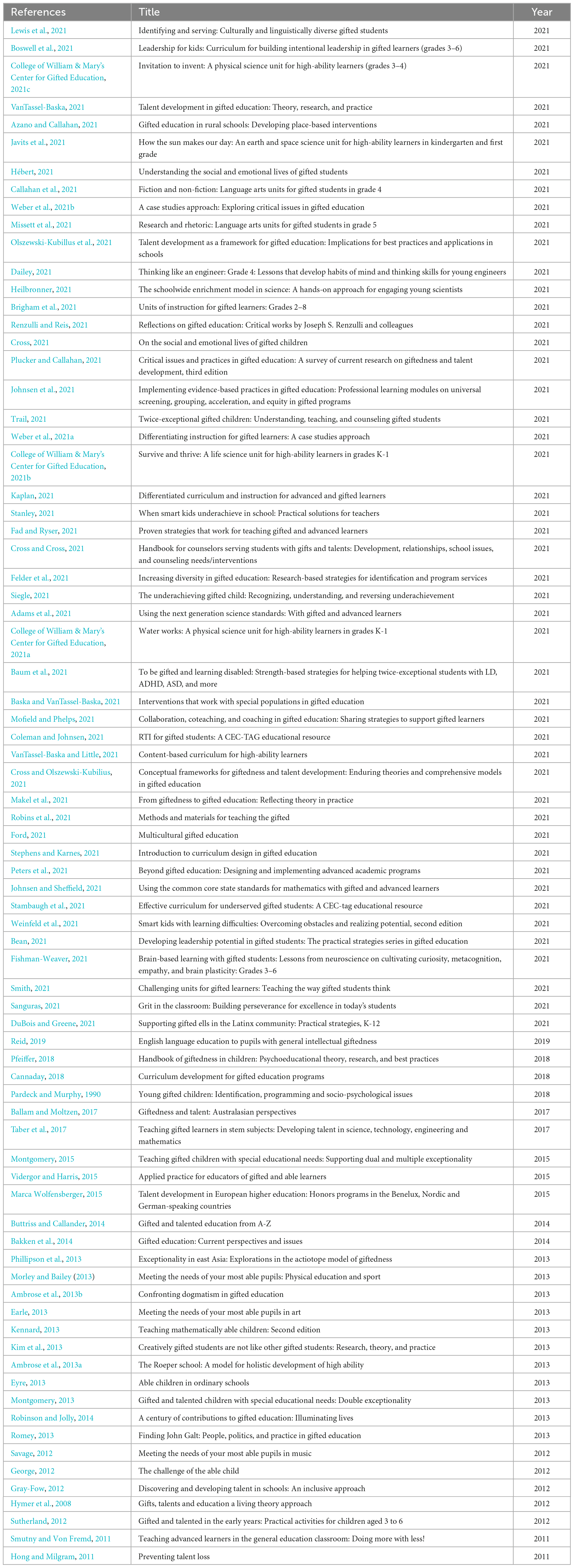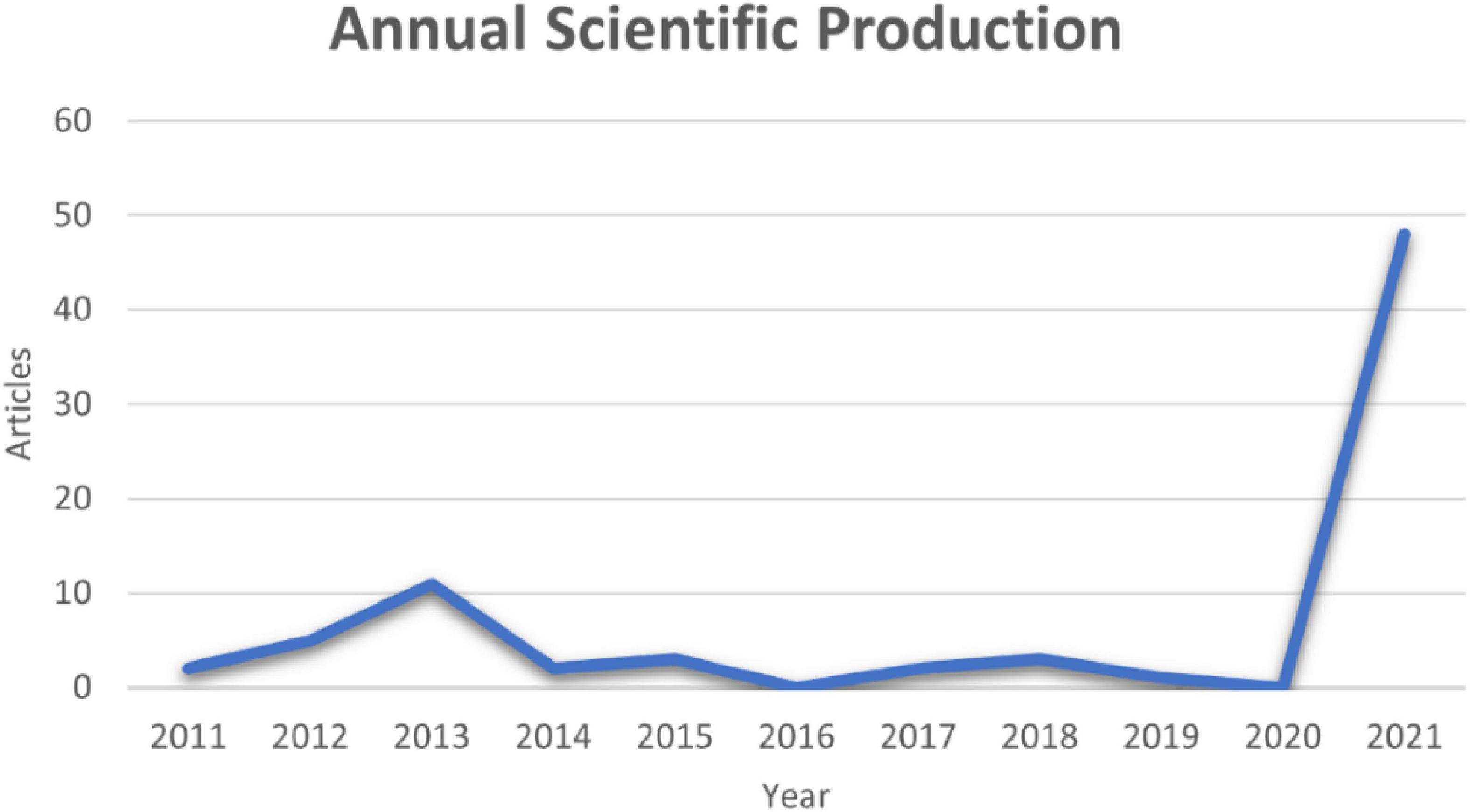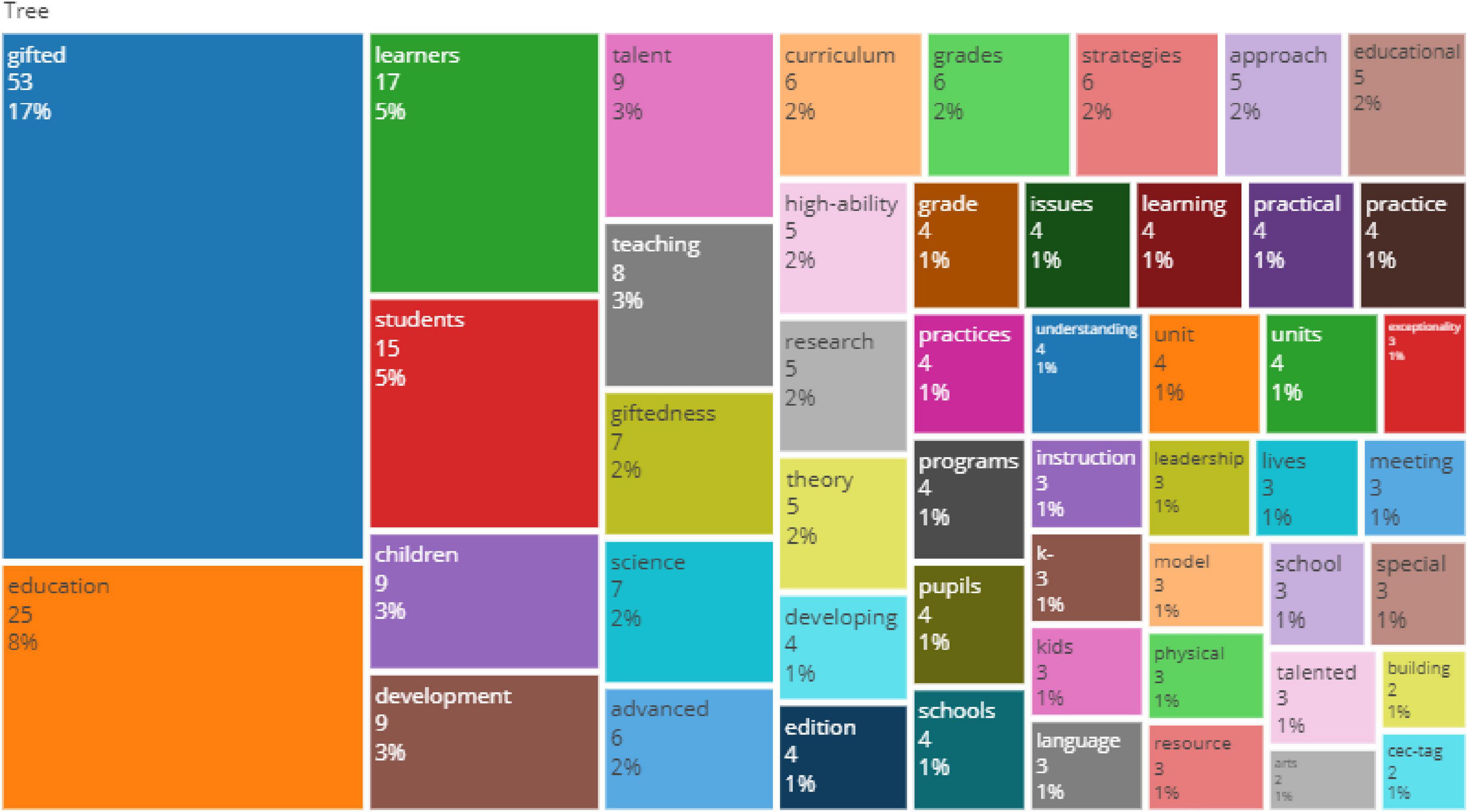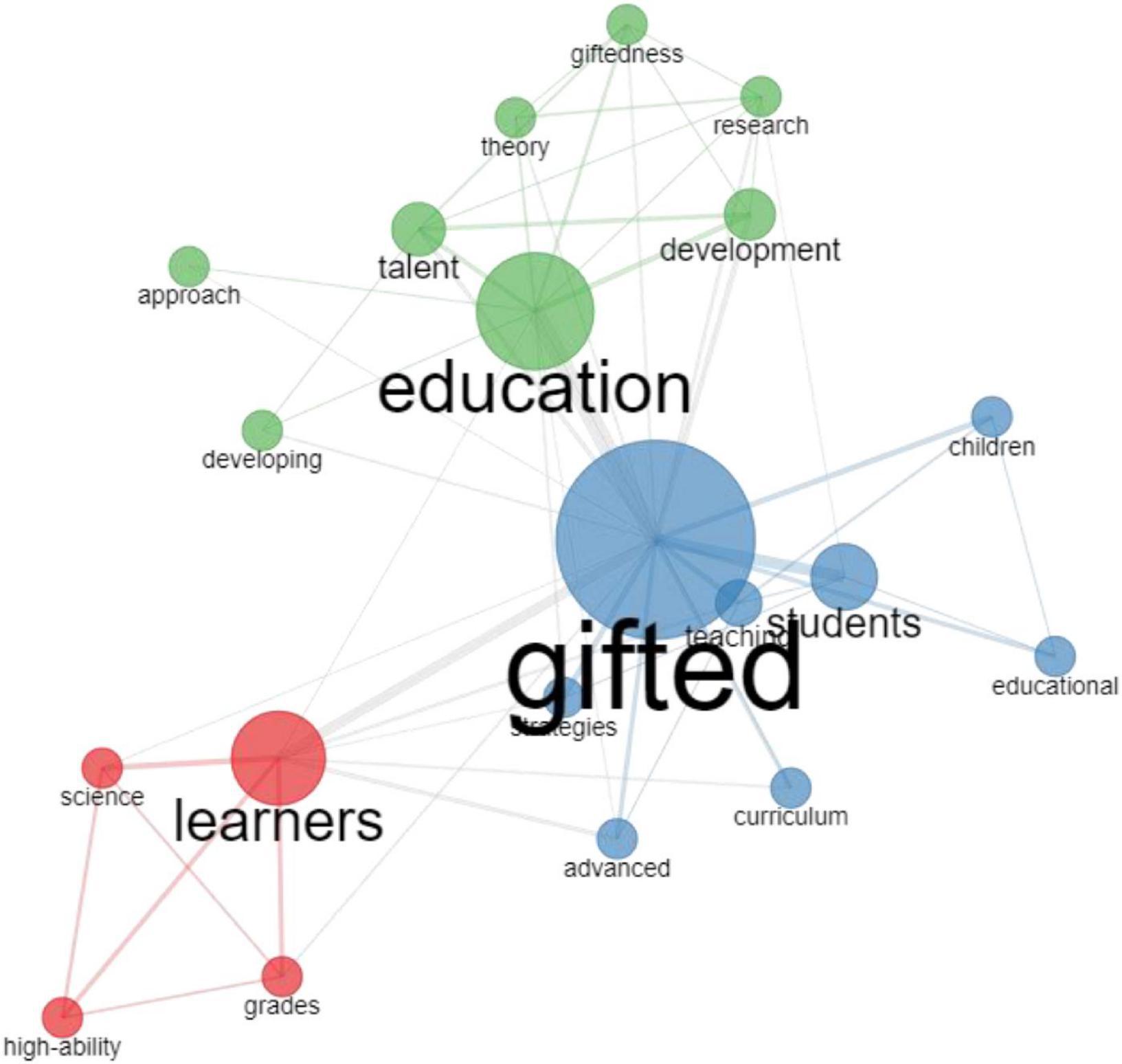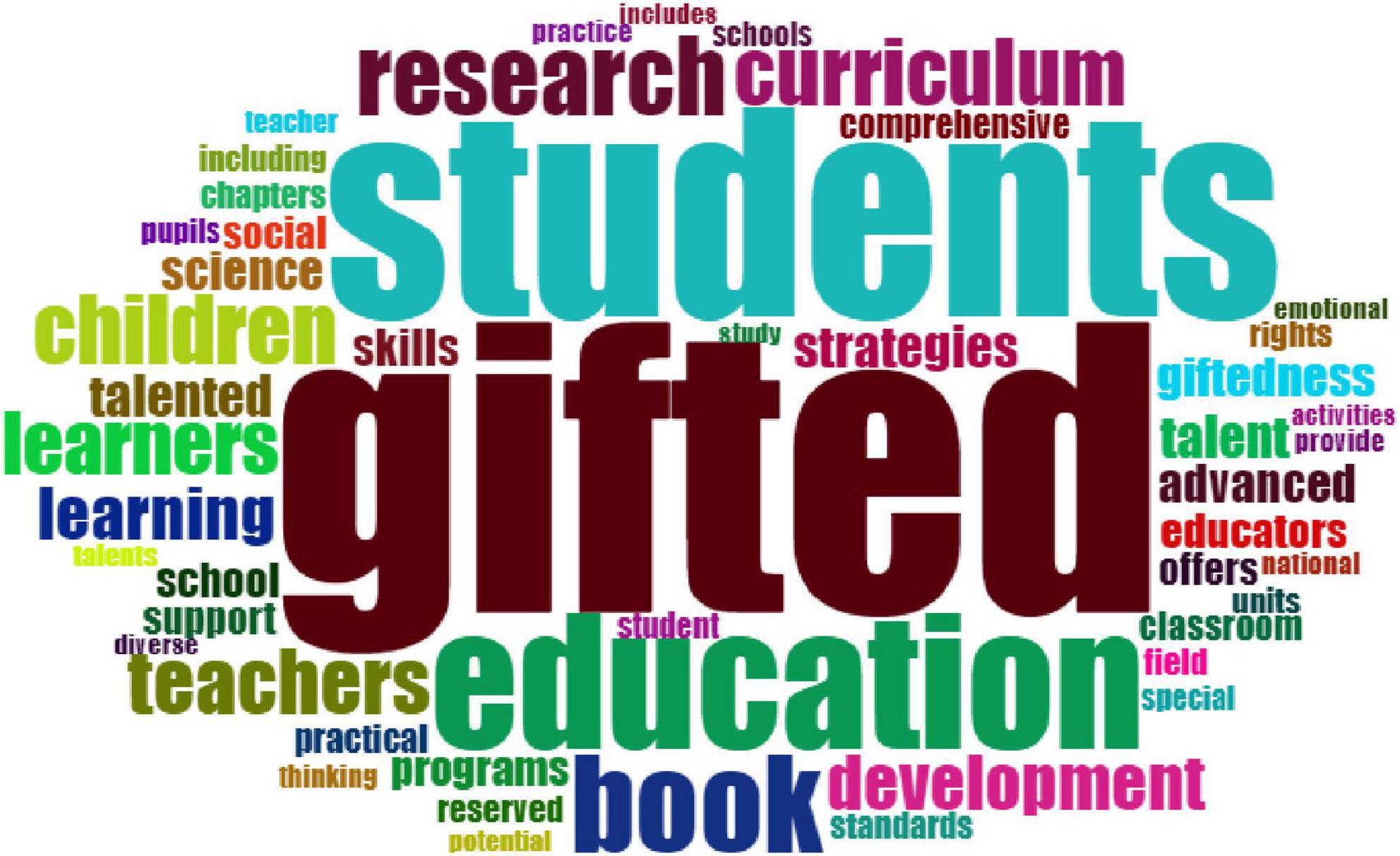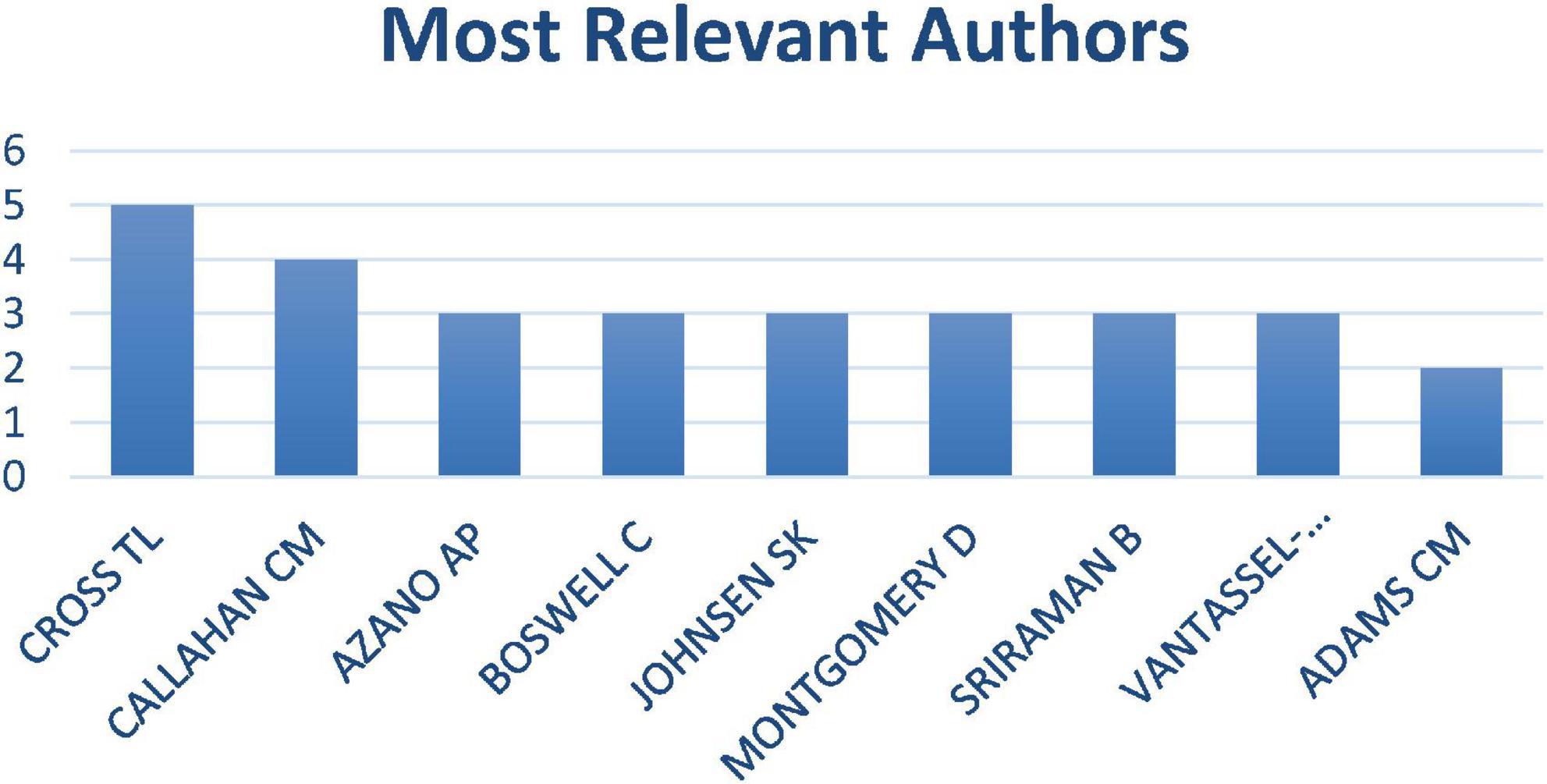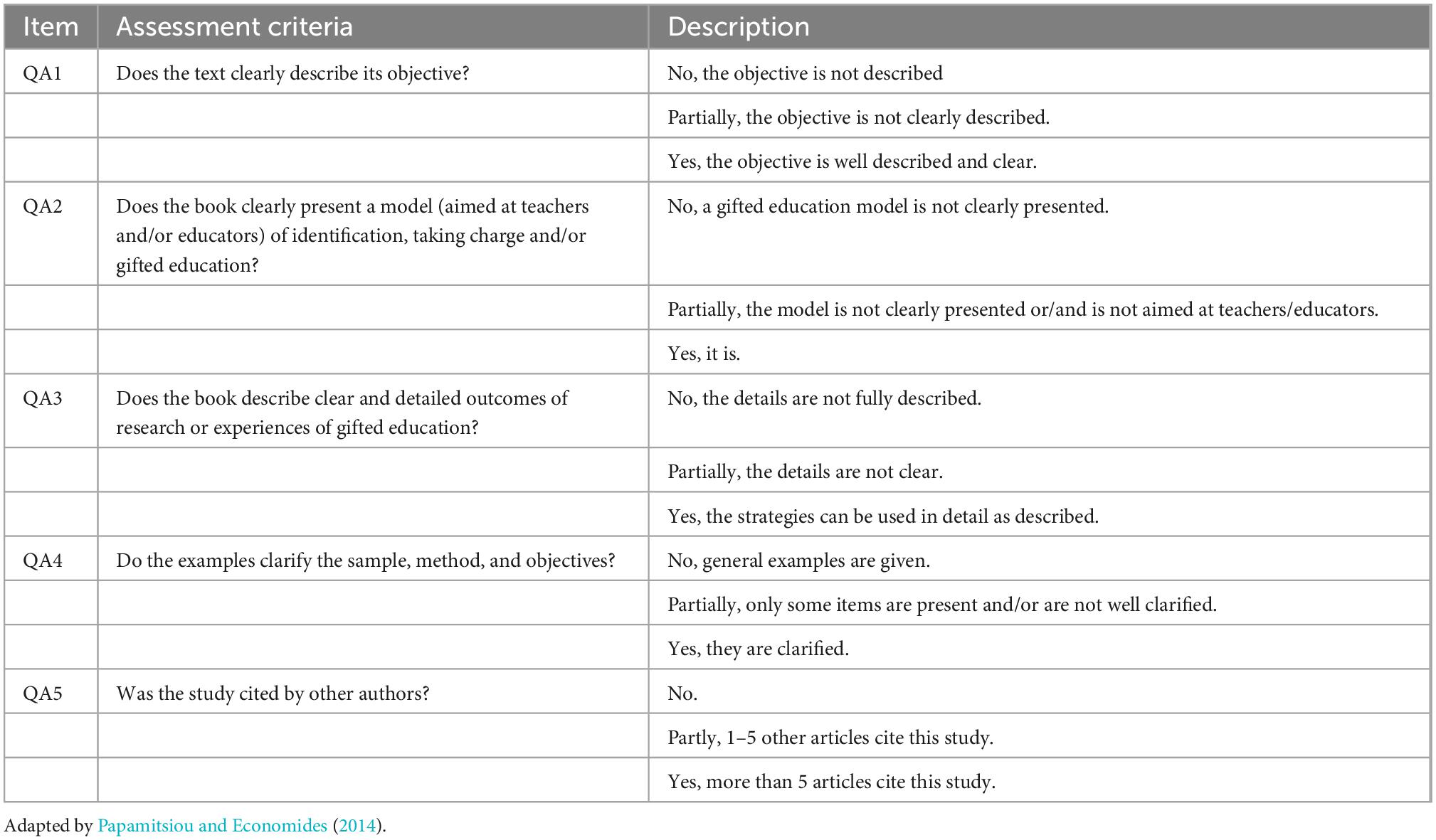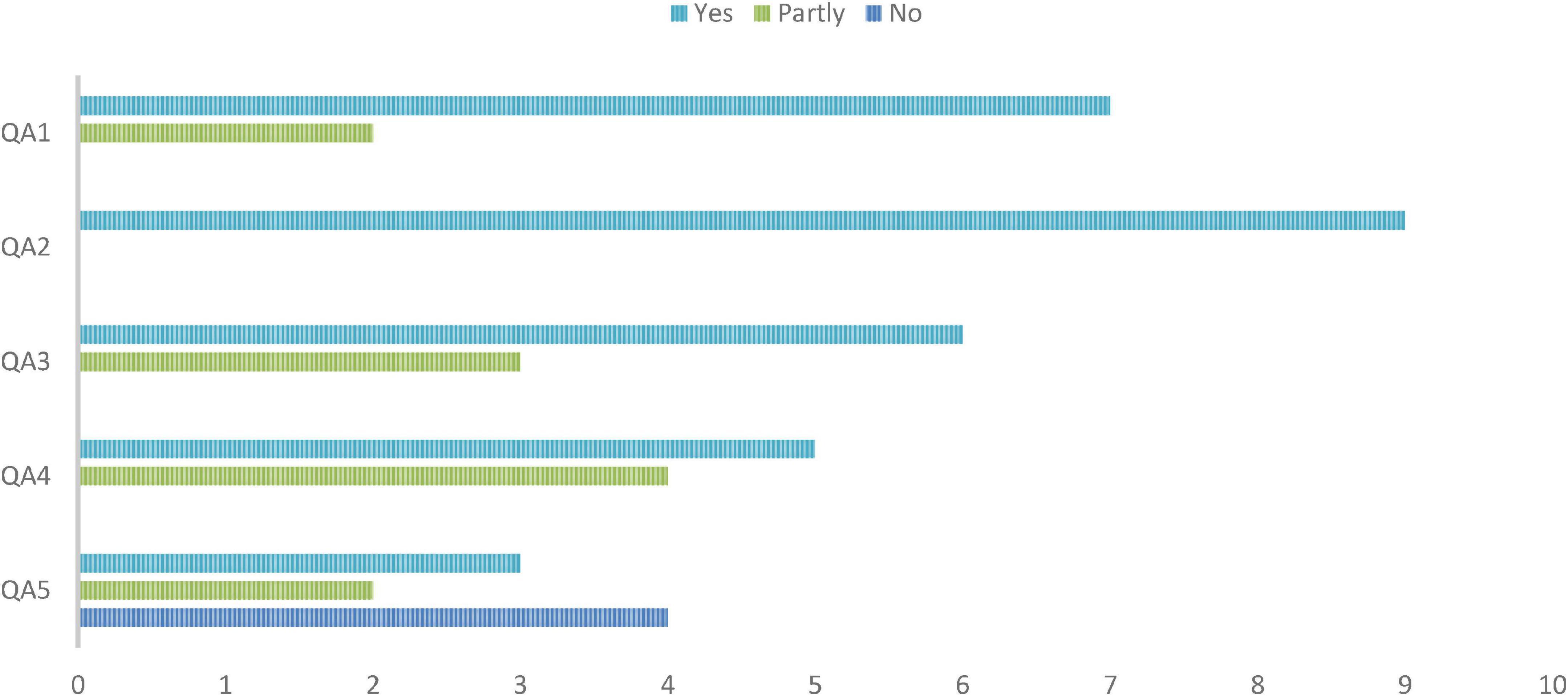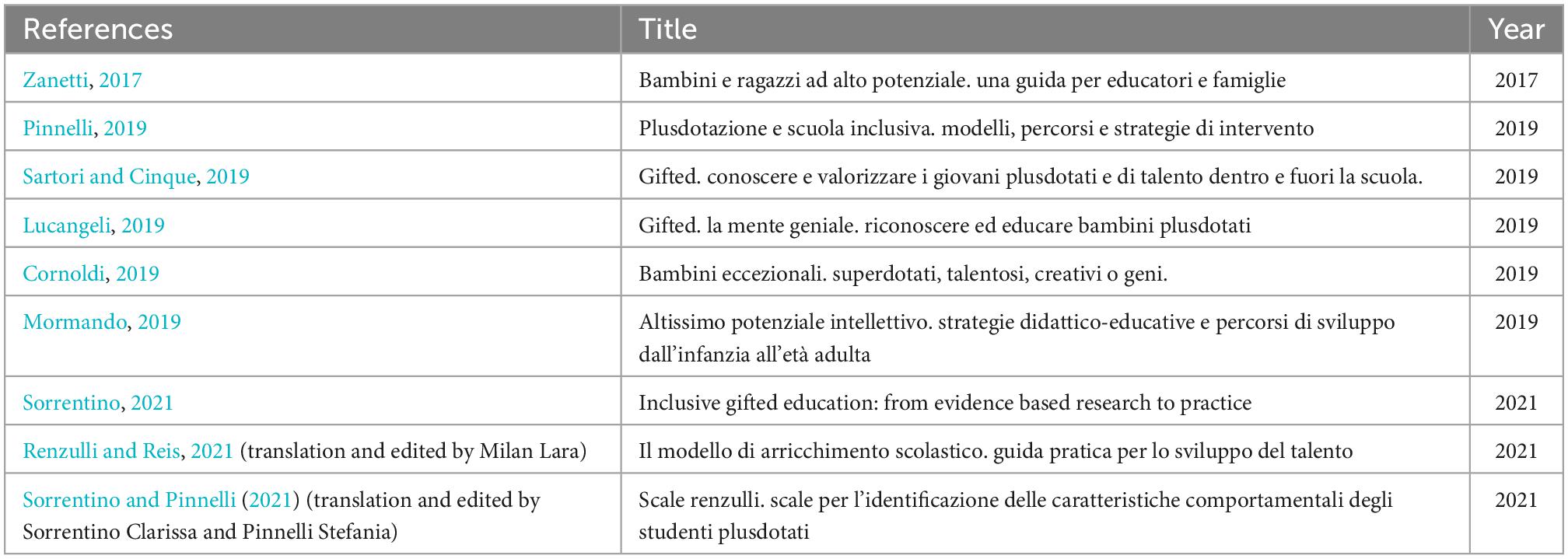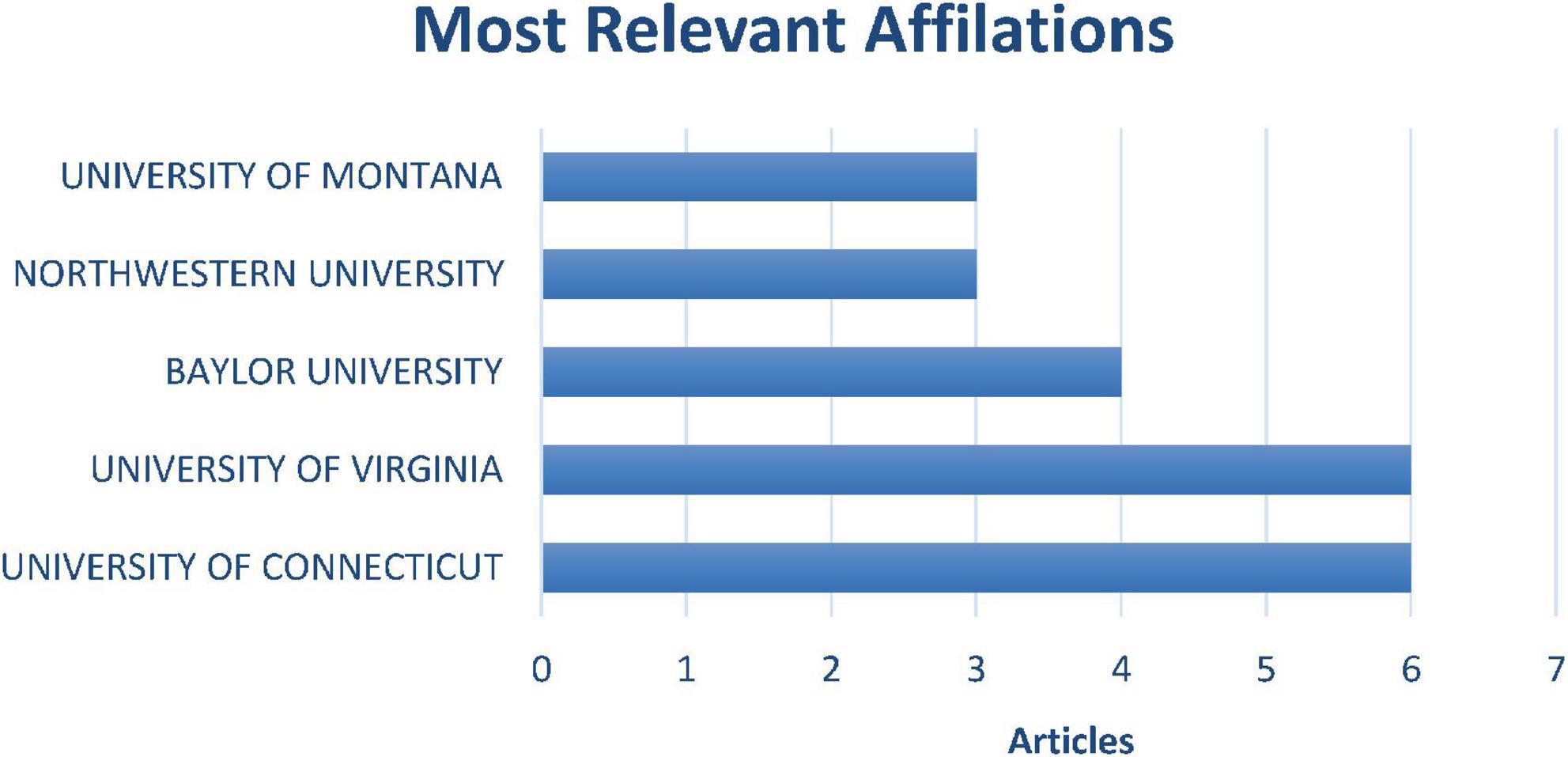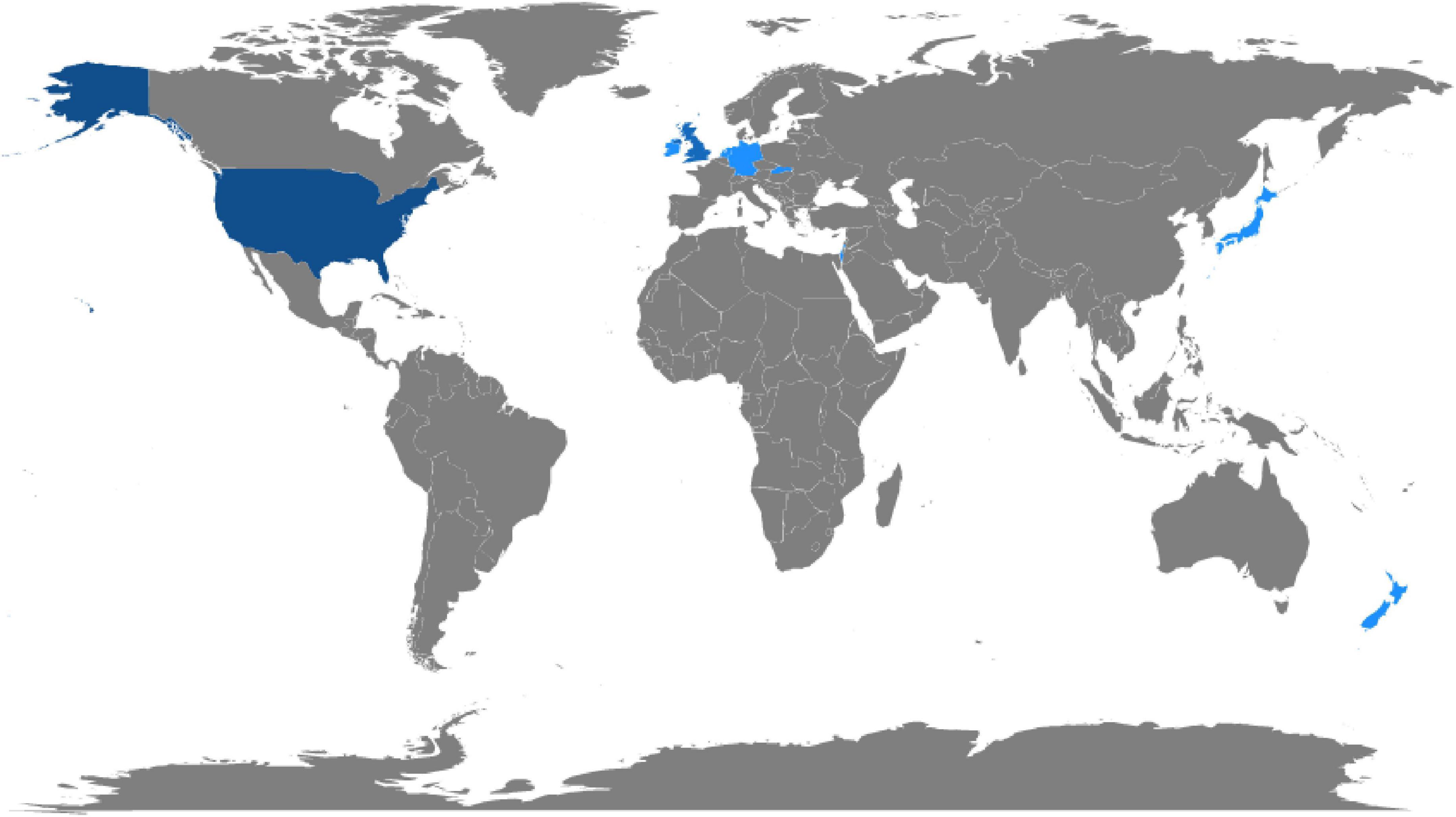- Department of Human and Social Sciences, University of Salento, Lecce, Italy
The present study aims to discuss the state of the art inherent in pedagogical-didactic research on the education of gifted students. To this end, a systematic review of scientific texts published between 2011 and 2021 was carried out. The present article is organized as follows: introduction to the topic; definition of the objectives, research questions, and methodological protocol; selection, evaluation, and synthesis of the abstract studies; discussion and evaluation of the results; and conclusions. Multiple tools for identifying the gifted students (for use by psychologists, pedagogists, educators, and teachers) emerge from the findings of the present study. The texts highlight numerous instructional and educational programming models for gifted students in all school grades. The main model is the SEM—(Schoolwide Enrichment Model). The present review shows a conspicuous production on gifted education, with the predominance of recently published articles (indicative of vivid interest in the topic) and of American origin. This geographic predominance, which does not cover the European and eastern parts of the world, may depend on the fact that the databases used [Scopus and Web of Science (WoS)] select results based on the use of English. This review reveals gaps and emerging trends in gifted education research, suggesting possibilities and future perspectives.
1. Introduction: Toward a pedagogy of talent: Gifted education and inclusive school
1.1. From a quantitative to a qualitative model of intelligence
The awareness of the role of educational context in the development of potential of gifted children formally emerged in the first national report on gifted education, the Marland (1972), in which the United States of America was recommended to take specific measures to support giftedness, emphasizing the need for customizing educational and didactic programming for these gifted students. Approximately two decades later, Recommendation 1248 (Parliamentary Assembly Council of Europe, 1994) was published in Europe, which reiterated the need for education, as a fundamental right of every individual, to be appropriate for all, emphasizing the importance of adopting special measures to support gifted individuals.
The first studies on giftedness were conducted in the field of psychometry and currently, the measurement of Intellectual Quotient (IQ) remains the main and the only method often used to identify gifted people (Carman, 2013). In 1921, Lewis Terman expressed interest in formulating the developmental process of children with high intellectual abilities. He initiated a longitudinal study involving 1,528 children between the ages of 8 and 12 years with IQs of at least 135. His goal was to show that IQ measured at school age remained unchanged in adulthood and inevitably translated into professional success. The research continued until his final years, and subsequent follow-ups were carried on by other researchers. However, contrary to the biological determinism hypothesized by Terman, the investigation made it clear that intelligence measured at school age was not a sufficiently relevant factor to ensure success in adulthood in professional life. This study corroborates the multidimensional theories that, beyond the genetic factor, variables such as sociocultural environment and intrapersonal factors are determinants.
In fact, in recent years, the advancement of research on the topic of giftedness has shifted the focus from a view of giftedness as permanent and rigidly linked to the individual (Galton, 1869; Terman, 1925; Witty, 1958) to a dynamic and multidimensional view (Renzulli, 1978; Tannenbaum, 1986; Gagné, 1993; Weisberg, 2006; Davis et al., 2011) of exceptionalism influenced, at multiple levels, by contextual systems (Bronfenbrenner, 1979).
1.2. Giftedness at school: legislation and needs
The turning point in Italian educational policy has recently come with MIUR Note No. 562 of 3 April 2019, which for the first time includes giftedness in an official document, formalizing the presence of gifted pupils among the Special Educational Needs (SEN). This development confirms the educational responsibility of teachers, already sanctioned by the regulation of Ministry No. 8/2013, to implement the personalization of teaching, also assessing the possibility of formalizing it in a personalized teaching plan.
Still today, this educational and didactic support for gifted students is perceived as exclusive and elitist (Fiorucci, 2017) with negative impact on gifted students who, if not adequately accompanied, find it difficult to live their own specificity and experiences of demotivation, frustration, and malaise (Pinnelli, 2017) that can degenerate into marginalization and psychological problems.
This elitist vision collides with the full inclusion model pursued by Italian and international policies. Emerged as early as 1978 in the Warnock Report (England), 15–20% of students at one time in their years of schooling are destined to encounter difficulties and for this reason, will need special support.
For this reason, European and international legislation directs schools to activate resources and prepare the educational context in the best possible way to support every diversity (intrinsic to each student) and develop every type of potential.
This right to full inclusion of gifted students in educational system and this commitment to universal education is enshrined in the Salamanca Statement (UNESCO, 1994) which states that “curricula should be adapted to children’s needs, not vice-versa (p. 22)”1 and, more recently, in the Convention on the Rights of Persons with Disabilities (United Nations [UN], 2006) that emphasizes the need for an inclusive education system at all levels and aimed at the full development of human potential.
Inclusive didactics do not propose equality but guarantee equity, that is, these didactics provide everyone with the educational measures they need, also paying attention to gifted students. As Aristotle already concluded in the Fifth Book of the Nicomachean Ethics “[.] What is fair and what is equal are the same thing, and, even both are good, equal is best” (EN 1137b 10-13).
Schools must be able to respond to the needs expressed by gifted students, which, in the Delaubier Report (Delaubier, 2002, p. 15–16), are summarized as follows:
1. The need for identification and recognition: the gifted child must be identified early in life to avoid the risk of situations of failure and suffering later in life. He/she must be understood in his/her complexity, supported, and encouraged in the knowledge of his/her qualities and fragilities.
2. The need to take charge of the student, with consequent attention to the specific difficulties to which giftedness could lead.
3. The need for motivation resulting from the frequent risk of boredom deriving from flat, repetitive, and not very challenging teaching.
4. The consequent need for complexity in learning that brings out the divergent and analytical thinking typical of gifted students, that is, instead, mortified by traditional teaching (based on single logical and sequential units).
The need for balance: the school must compensate for the tendency to intellectual overinvestment typical in these children with social, physical, affective, and moral education.
The fulfillment of personal and educational needs is a necessary condition to guarantee the gifted pupil’s wellbeing. This scenario is often hindered by teachers’ beliefs about giftedness who as teachers, driven by the need to understand, absorb information readily available in context. However, this information is distorted and reductive and consequently impedes specific educational action toward gifted students. Among the myths, the myth of self-sufficiency (Pinnelli, 2019, p. 24) supposes the complete autonomy of gifted students who do not need help or adaptations to always be successful. This superficial view does not consider all the variables that influence performance (e.g., motivation, self-efficacy, control and learning strategies, and resistance to stressors) that need to be enhanced in tailor-made educational interventions.
Indeed, giftedness can be related to high achievement and positive school adjustment as well as to difficulties and underachievement. To avoid such negative outcomes and accommodate the above-mentioned needs, didactic-educational planning must be personalized and aim at the development of both learning potential and socio-emotional skills.
1.3. Systematic literature review as an orientation tool for gifted education
For these reasons, this systematic review of the literature adopts a specifically didactic and pedagogical slant, aiming to offer an orientation tool among the texts on educational methodologies and gifted education models, escorting toward an appropriate takeover of the gifted student.
The decision to limit inclusion in textbooks is motivated by the need to choose works in which the applied methodological dimension is amply argued in terms of teaching practices and learning outcomes. In particular, the argumentation on the validity of a teaching practice must be accompanied by precise and extensive indications on the aims and objectives of the teaching-learning sequence, the methodologies and tools used, the assessment of initial, mid-term, and final learning, examples of activities, qualitative observations on the performance, analysis of results, and reflection on the development of good practices. Although scientific articles based on empirical studies, through the review process, ensure quality and scientific rigor, such articles have a limited number of usable characters and pages. Therefore, the applied methodology is often summarized in a coherent and concise discourse. For these reasons, a more extensive and elaborate dissertation, full of examples, observations, and details, is more likely to be found in textbooks and not in articles with limited pages and characters.
The present review was initially conducted by operating on the main international bibliographic databases (Web of Science and Scopus). In this first analysis, the emergence of very few Italian papers highlighted the limitation of the “citation subculture,”2 that is, a disparity between subject areas in the retrieval of bibliographic sources in databases indexed based on the quantitative citation analysis.
The underrepresentation of Italian Social Sciences and Humanities (SSH) scientific literature in the mentioned databases is due to the fact that the field of educational science is characterized by qualitative evaluations and, as Sani (2012, p. 186) states, it is still not very internationalized but this does not mean that it is not a reflection of science characterized by innovation and quality.
To overcome these limitations and include in the systematic literature review on the topic of gifted education books by national authors that may escape academic databases (but are relevant to the review), Google Books was used.3
2. Methodology
To understand the development and state of the art on research in the field of education of gifted students, a systematic literature review was conducted, based on the guidelines outlined by Kitchenham and Charters (2007). The process followed three main steps that were divided into several steps (Figure 1). Subsequently, Bibliometrix software (Aria and Cuccurullo, 2017) was used to extract and process the datasets.
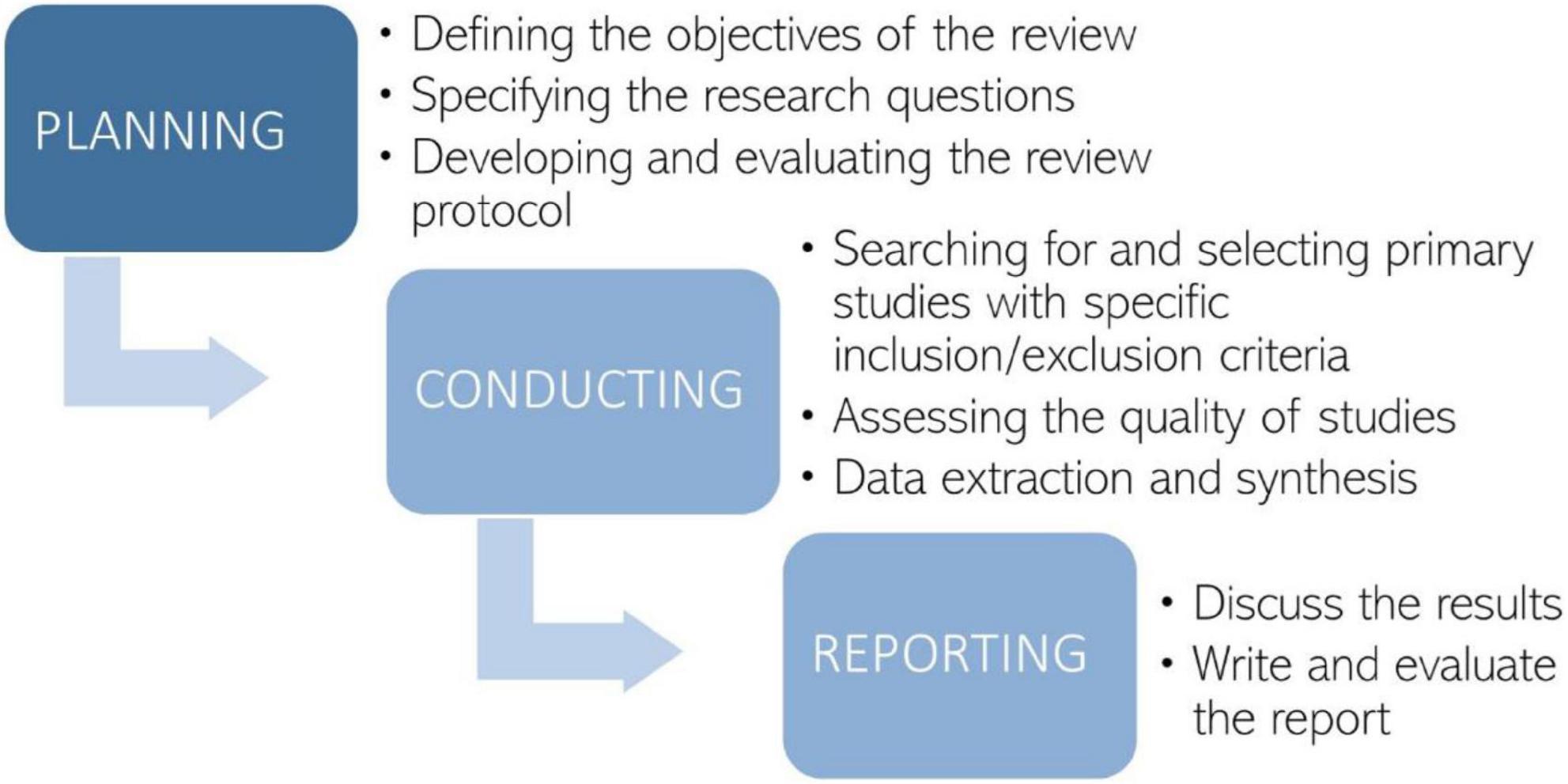
Figure 1. Process of systematic literature review (adapted by Kitchenham and Charters, 2007).
2.1. Planning
2.1.1. Defining the objectives of the review
Based on the guidelines, the first step in conducting a systematic literature review is to define the objectives. This study reviews the existing Italian and international literature on gifted education with the aim of:
RO1: Identifying the state of the art in pedagogical and didactic research on education and talent development
RO2: Identifying possible gaps and future research perspectives on the subject.
2.1.2. Specifying research questions
To identify the primary studies and to guide the data extraction and analysis processes, the following research questions were formulated:
RQ1: What models are used by schools to identify and take care of gifted students?
RQ2: What teaching methodologies, educational practices, and school programs are dedicated to supporting and developing potential and talent?
2.1.3. Developing and evaluating the review protocol
The research method used during the systematic review process was based on the review protocol. Specifying the method adopted for the review helps to reduce the risk of unintentional errors. During the planning phase, informal and formal searches were used to identify objectives and research questions underlying the review process. The methodology is based on the PRISMA (Preferred Reporting Items for Systematic Reviews and Meta-Analyses)4 model.
2.2. Conducting
2.2.1. Searching for and selecting primary studies with specific inclusion/exclusion criteria
To delimit the selection of studies related to the topic of the review, some keywords were identified. According to Cronin et al. (2008, p. 41), considering alternative terms with corresponding meanings is crucial for maximizing the amount of information in a literature review. For this purpose, the search string also included synonyms used in different combinations through the Boolean operators “and” and “or,” which expand or limit the search product.
The final search string was: “giftedness” OR “gifted education” OR “plusdotati” OR (“plusdotazione” AND “Scuola”).
The search was conducted on international bibliographic databases (Scopus and Web of Science (WoS)) selected for the following criteria: international spectrum and qualitative evaluation of indexed sources (Impact Factor and h-index). The number of results was subsequently reduced using both the inclusion and exclusion criteria. In Web of Science, the query was performed in the “Topic” field (including title, abstract, and keywords) with the following criteria (Table 1):
1. Categories: Education Educational Research, Education Special.
2. Document Types: Books.
3. Publication Years: 2021, 2020, 2019, 2018, 2017, 2016, 2015, 2014, 2013, 2012, 2011.
4. Language: English, Italian.
In Scopus, the search was performed in the field “Article Title, Abstract, Keywords” with the following criteria (Table 2):
1. Publication Years: 2021, 2020, 2019, 2018, 2017, 2016, 2015, 2014, 2013, 2012, 2011.
2. Subject Area: Social Sciences.
3. Document Types: Books.
4. Language: English, Italian.
The initial results of the search across all databases produced a total of 22,854 articles, which when subjected to inclusion and exclusion criteria were reduced to 348.
2.2.2. Assessing the quality of studies
Subsequently, a thematic analysis procedure was performed: the abstracts and the index of the texts (where present) were read and analyzed, and the 271 texts that did not include any empirical evidence or were far removed from the disciplinary context and research questions were also removed. The remaining 77 texts were then considered for systematic review. The PRISMA process followed is illustrated in Figure 2.
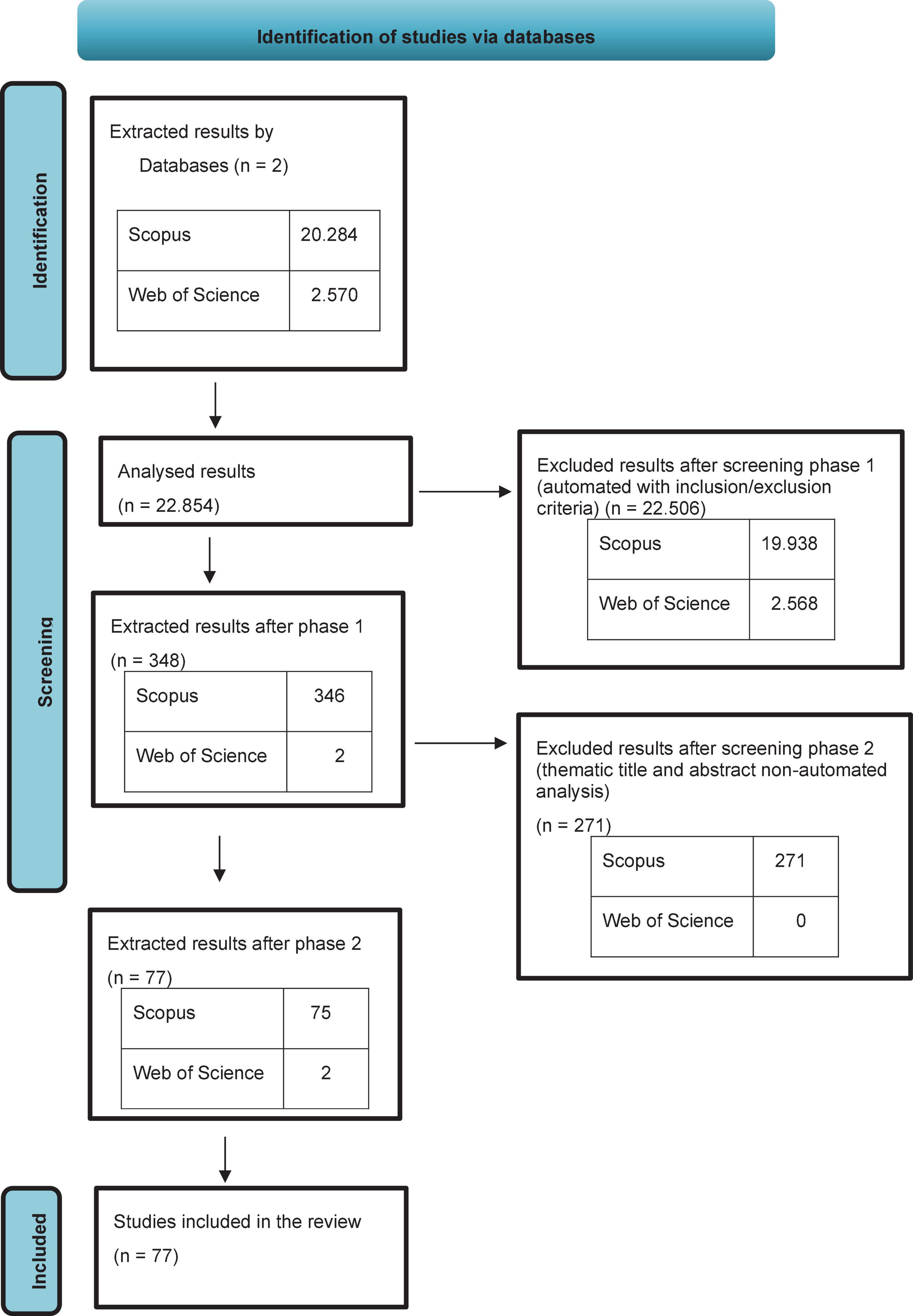
Figure 2. Review process PRISMA (Preferred Reporting Items for Systematic Reviews and Meta-Analyses) (Page et al., 2021).
2.2.3. Data extraction and synthesis
The studies included in the review are reported in Table 3.
The search results were acquired in. bib format and processed using Bibliometrix software (Aria and Cuccurullo, 2017), which made it possible to extract basic information, publication details, and specific data from each article based on the initial categorization of the study. The annual output of the articles selected for the systematic review undergoes an exponential increase: in the first year of the decade under review, 2 articles were published, and in the last year considered, 48 (Figure 3).
As regards the titles of the works examined, Figure 4 shows the tree map of the most recurring words with their percentages and Figure 5 the co-occurrence network map of the most used keywords.
The wordcloud (Figure 6) reveals the main keywords related to the abstracts of the analyzed texts.
2.3. Report
As regards the first research question (RQ1), the models for identifying and taking charge of gifted students are numerous. One reason for this is the existence of various conceptualizations of giftedness (Cross, 2021). VanTassel-Baska (2021) explains how the idea of gifted development has always been radicalized into two distinct visions that have to do with the idea of ability. Ability is understood as genetic baggage that we bring into the environment with birth, or, on the other hand, the ability is shaped by the environment during growth. These two perspectives synthesized in the phrase “nature or nurture,” underlying two different attitudes of schools in taking charge: (1) the use of standardized tests to identify students with high IQs for whom we need to target advanced programs and (2) designing advanced educational interventions from which all students could benefit (VanTassel-Baska, p. 3).
Today, the paradigms underlying the construct of giftedness that guide its identification are multidimensional, that is, they presuppose an interaction between innate variables and environmental stimulation. The theoretical frame of reference can be traced back to psychological studies on the diversity of individual types of intelligence (Gardner, 1983; Sternberg, 2003), which emphasize the variety of learning profiles and domains of excellent performance. The identification of gifted students thus becomes a mediation of case-specific procedures to be chosen because of the person’s characteristics and ranging from the professional use of validated instruments to observation protocols by school staff and family, to checklists for self-identification up to peer nomination.
One of the biggest risk factors for not identifying students is underachievement. Possible causes of underachievement at school with corresponding counterstrategies are outlined by Stanley (2021) and Siegle (2021).
The present review includes volumes (Montgomery, 2013, 2015; Baum et al., 2021; Trail, 2021) that guide the identification of students with dual or multi-exceptionality, that is, students who co-occur with giftedness have one or more clinically relevant conditions. These co-occurring factors may not emerge due to a masking effect: it may be that the difficulties mask the giftedness or that the giftedness masks the difficulties, or that the high intellectual abilities lead to finding effective strategies to compensate for the deficit and neutralize both.
In response to the second research question (RQ2), the best educational and teaching practices aimed at talent development which can be divided into two contiguous macro-categories:
- School programs and methodologies based on enrichment (i.e., an expansion of the training offer) that aim to increase competence in specific content-disciplinary areas, for example, related to science (Adams et al., 2021), mathematics (Kennard, 2013; Johnsen and Sheffield, 2021), and STEM (science, technology, engineering, and mathematics) subjects (Taber et al., 2017), earth science (College of William & Mary’s Center for Gifted Education, 2021a,b,c), music (Savage, 2012), art (Earle, 2013), physical education and sport (Morley and Bailey, 2013), and in the study of the English language (Reid, 2019).
- Programs to develop soft skills such as leadership skills (Bean, 2021; Boswell et al., 2021), critical reading skills (Callahan et al., 2021; Missett et al., 2021), engineering design (Dailey, 2021), creativity (Kim et al., 2013), grit and perseverance (Sanguras, 2021); curiosity, neuroplasticity, metacognition, empathy, and wellbeing (Fishman-Weaver, 2021), social and emotional development (Cross, 2021; Hébert, 2021).
The above-mentioned volumes provide principles, teaching techniques, examples of activities, and materials for use by tutors, teachers, and educational staff. The model behind the suggested interventions is easily available in Renzulli and Reis’ Schoolwide Enrichment Model Renzulli and Reis, 1985, 1994, 1997, 2014, 2021, which aims to develop the strengths and talents of all students because, as the authors write, “A rising tide lifts all ships” (Renzulli and Reis, 2014, p. 5), proposing enriched learning experiences and higher standards of knowledge that can benefit all children. An example of the application of SEM to the science curriculum is presented in Heilbronner (2021). Another inclusive and effective educational model for talent development is educational differentiation that aims to vary methods, strategies, and educational objectives in response to the variability of the class group. A clear framework is presented in Kaplan’s (2021) text, and various case studies of differentiated teaching for gifted children are presented in Weber et al.’s (2021a) text.
Some volumes propose guidelines for underrepresented gifted students: Azano and Callahan (2021) present educational programming for gifted students living in high-poverty rural areas of the United States of America; Baska and VanTassel-Baska (2021), Felder et al. (2021), and Stambaugh et al. (2021) provide effective guidelines for meeting the educational needs of gifted students with different linguistic and cultural backgrounds or those who are in poverty or for the twice exceptional; good practices in the case of twice and multi-exceptional are also illustrated by Weinfeld et al. (2021).
Figure 7 shows the most relevant authors in the review.
The author with the most productions is Tracy L. Cross, Ph.D., an educational psychologist, Professor of Psychology and Gifted Education, President Emeritus of the NAGC (National Association for Gifted Children), and founder of the Center for Gifted Education, a research and program development center for gifted people, located at the College of William & Mary in Virginia. In second place is Carolyn M. Callahan (Ph.D. in Educational Psychology and Professor at the University of Virginia), while in third place, tied, are Amy P. Azano (Ph.D., Professor in the School of Education at Virginia Polytechnic Institute); Cecelia Boswell (Ed.D., educator, gifted education consultant in Texas); Susan K. Johnsen (Ph.D. in Special Education and Educational Psychology, Professor in the Department of Educational Psychology at Baylor University, Waco); Diane Montgomery (Ph.D., Psychologist, and Professor of Education at Middlesex University, London); Bharath Sriraman (Ph.D., Professor of Mathematics at the University of Montana, Missoula); Joyce VanTassel-Baska (Ed.D., Professor Emeritus of Education in the College of William & Mary, Virginia).
As previously mentioned, a second selection step was carried out on Google Books to include scientific products that, due to the “citation subculture,” had eluded the bibliometric database search.
The previously identified query was launched in Google Books. The initial results of the search in the search engine produced a total of 2,010 articles which, when subjected to the inclusion and exclusion criteria, were reduced to 321. Subsequently, a thematic analysis procedure was carried out: the abstracts and the index of the texts were read and analyzed, and those results far from the disciplinary context and research questions were removed, as well as texts with a non-scientific-academic slant. The remaining nine volumes were then selected for review and assessed for quality. The checklist chosen and adapted for the assessment of the quality of the studies is that of Papamitsiou and Economides (2014; Table 4), which involves descriptive questions with answers on a 3-point Likert scale.
In the first criterion (QA1) “Does the text clearly describe its objective?” the description of the objective of the text was assessed, which was made explicit in seven of the papers. In the second criterion (QA2) “Does the book clearly present a model (aimed at teachers and/or educators) of identification, taking charge, and/or gifted education?” examined whether the studies clearly presented a model for teachers/educators to identify, plan, and take charge of gifted students. This criterion was met by all the texts. As far as the third criterion (QA3) “Does the book describe clear and detailed outcomes of research or experiences of gifted education?” is concerned, this study confirmed that six works clearly and in detail describe the results of research and experience on the subject. The fourth criterion (QA4) “Do the examples clarify the sample, method, and objectives?” assessed whether the studies clearly presented the sample, method, and objectives, which were analytically clarified by five texts. The fifth criterion QA5 “Was the study cited by other authors?” concerned citations of the study in other documents. Google Scholar5 was used to check the number of citations. Of the nine texts included, three were cited more than five times in another research.
Figure 8 shows the results of the quality assessment.
According to the quality assessment checklist, QA5 was the only item that was not sufficiently satisfied. However, given the limitations of the citation system mentioned above,6 all nine books (Table 5) were included in the review.
2.3.1. Discussion
All the texts turn out to be a valuable orientation tool for teachers and educators in their knowledge of models and instruments aimed at identifying the gifted student and accompanying him or her with a personalized educational program that embraces his or her educational needs and counteracts possible risk factors (misdiagnosis, socio-emotional difficulties, underachievement, and/or dropping out of school).
In the magnum sea of models and definitions of the construct of giftedness, Cornoldi (2019) tells the stories of Roberto, Magda, Giovanni, and Maria Luisa: four children with four different types of exceptionalities, making intelligible the variety within the construct of giftedness. These include the “unmeasurable” ones to which 7 devotes a chapter: imagination; creativity; intuitive thinking; and empathy. The relationship between talent and creativity is also addressed by Lucangeli (2019).
Zanetti (2017) clarifies the fundamental question that it is not “What is giftedness and how is it measured?” but rather is “What does the social, school, and family environment do to promote opportunities for growth [.]?”8 Indeed, there is no gifted prototype because both the profiles and talents of people with giftedness are extremely complex, heterogeneous, and unique. Precisely in order not to dissipate this valuable uniqueness, the school context must equip itself to be able to recognize each type and expression of potential and know how to develop it, supporting students in their growth process with individualized paths that counteract situations of discomfort and suffering.
Zanetti9 informs us of the main problems reported by teachers of gifted children: difficulties in peer relations and behavioral problems in the classroom. Social-relational difficulties are attributable to being “out-of-sync” (Silverman, 2002) with advanced cognitive development compared to emotional and social development. “When advanced cognition leads to awareness of information for which the child or adult is emotionally unprepared, vulnerability is the natural result.”10 Behavioral problems, on the other hand, may result from the boredom children experience in front of already acquired knowledge. Possible solutions, as recommended by the author, are engaging students in peer tutoring activities, freely choosing the learning activity, supplementary or enrichment activities, and working in groups. The volume edited by Pinnelli (2019) consists of three parts (research and reflection; family and educational contexts area; and teaching area) that offer a comprehensive view of the state of the art about giftedness and offer a multilateral perspective of the contexts experienced by gifted people. To complement this volume on giftedness, the text offers case studies and specific scenarios, suggesting intervention strategies with an entire chapter dedicated to didactics for gifted pupils and a focus on didactic differentiation and related working strategies (Tic Tac Toe Strategy, Menu Strategy, and Cubing Strategy). The study stimulates a reflection on how to operationalize inclusiveness in different environments and informs us of the risk of categorizing giftedness in standards and labels, that is, of thinking about it in terms of clichés. The author analyzes the most common misconceptions of teachers on the subject, which are complicit in non-intervention: the myth of guaranteed scholastic success, that is, the belief that gifted people do not need specific interventions to excel; the myth of the ineluctable expression of talent, that is, the opinion that talent emerges spontaneously even in the most hostile environment; the myth of happiness, that is, the minimization of the sentimental complexity of gifted people, who are instead seen as always happy.11
As proof of the fallacy of the myth of happiness, Sartori and Cinque (2019) focus on the “complex and articulated constellation of emotional and relational characteristics of gifted people”12 that could condition the expression of potential: low self-esteem, perfectionism, a tendency to isolation, high sensitivity, rigidity in dealing with situations, and arborescent and dispersive thinking.13
The book, edited by Sorrentino and Pinnelli (2021), is an orientation tool for identifying gifted students. In a circularity between the theory and educational practice, the construct of giftedness is presented to teachers, guiding them toward a focused observation of the student’s potential and the design of targeted and personalized teaching interventions based on the interests and peculiarities of the individual. The theoretical framework is identified in the SEM, the Schoolwide Enrichment Model (SEM) developed by the American professor Renzulli (1977), a pioneer in gifted education studies. Renzulli defines gifted behavior as an intersection of the above-average ability in any field, motivation, and creativity interacting with each other to create a diversity of gifted profiles. This “talent pool” is affected by contextual stimulation and, for this reason, schools must offer a vast spectrum of educational and teaching opportunities appropriate to their development. To be nurtured, the potential must first be identified. To address this need for identification, the authors validate the tool for teachers’ use. The validation was conducted on an Italian sample. The tool allows to investigate the presence of gifted students from 8 years of age or above, assessing their behavior and abilities compared to peers in various areas, according to a 6-point Likert scale.
There are 14 areas to be observed and they can be divided into basic scales (learning, creativity, motivation, and leadership); science area scales (artistic aptitude, precision, and communicative expressiveness, planning), and transversal scales (science, technology, reading, mathematics, music, and drama). The scale scores are to be interpreted based on local percentiles that can be determined by accessing the online resource provided by the book. As an addition to the original text, the Italian edition of the Renzulli Scales guides the reader in a comparison between the Italian school model and the US model in taking care of gifted pupils. Furthermore, the volume edited by Pinnelli and Sorrentino accompanies a formation in the use of the Renzulli Scales: teacher training. In a harmonious balance between testing and observation, between the subjective and the objective, the school is equipped with a decisive tool to assume a practical definition of giftedness, facilitating the identification, inclusion, and promotion of differences.
At the same time, emphasizing the Renzulli model, a necessary book for programming interventions aimed at the valorization of exceptionalities is the practical guide to the SEM—School Enrichment Model, edited by Milan (2021). The SEM “provides enrichment opportunities for all students and, at the same time, ensures advanced activities for those pupils who are highly motivated and have high skills and performance” (Milan, p. 5) by including them within the regular school curriculum. In fact, Renzulli and Reis do not say of giftedness but of “gifted behaviors” to emphasize the idea of the dynamism of gifted behaviors that occurs “in certain people, at certain times and in certain circumstances” (Milan, 2021). The SEM starts from the assumption that schools should be the place for the development of giftedness (Renzulli, 1994) and therefore places the student and his/her wellbeing at the center of educational action, adopting teaching strategies to enhance the student in all his/her complex identity. Teachers help learners understand their strengths (abilities, interests, and learning styles) and enter the information into a management model called the Total Talent Portfolio, which is then used to decide on the educational services to be offered to develop potential. The personalization of the pupil’s learning program is enabled by the compacting of curriculum, which makes it possible to eliminate the part of the program that has already been learned and the repetition of previously acquired tasks, thus ensuring that time is found for more challenging activities aimed at advanced and motivating objectives to enable the development of personal abilities and talents (Renzulli and Reis, 1998). This development takes place from an enrichment perspective that increases creative productivity by exposing students to a variety of topics, ideas, and areas of study and then subsequently teaching them to apply advanced content in those areas.
In the last part of Sorrentino’s (2021) book, which offers a precise comparison of international educational policies and models of educational identification and intervention, there is experimentation of Renzulli’s Total Talent Portfolio with a 13-year-old student who was not considered gifted by his teachers and in a situation of school underachievement with consequent experiences of demotivation. The compilation of the Total Talent Portfolio prompted the student to reflect on his abilities and the importance of commitment to transform these abilities into talent.14
3. Conclusion
3.1. The limit of “citation culture”
In Figures 9, 10, we note how almost all the universities involved in the review are American, in spite of the significant and important research contribution of the European Academy and the eastern part of the world (especially Australia). Although the present review is deliberately restricted to the pedagogical-didactic area, it is evident that most of the authors come from the psychological disciplinary field and not from the pedagogical one. Although an interactive network between the professional figures like the psychologist, the pedagogue, and the educator is indispensable and fruitful for improving the field of education of gifted students, this fact has pointed out to avoid the risk of persevering in a psychometric model of interpreting the educational process and as an appeal for more systematic educational research.
This geographic and scientific-sectoral predominance could depend on two reasons: the well-known criticality of the databases used (Scopus and WoS) for the humanities and social sciences relating to the “strong predominance of Western English-language journals” (Turbanti, 2014) and the “citation culture” (Wouters, 1999, p. 2): a subculture that, over the last two decades, has gradually evolved to the point where work is evaluated according to the number of citations obtained. Wouters (pp. 210-212) points out the presence of multiple “citation cultures,” that is, multiple habits and logics regarding citations that are different in the various disciplinary areas of interest. For example, as the University of Palermo Library Portal explains, the use of bibliometric indicators (based on the quantitative citation analysis) is not sufficient as a measure of performance in the social sciences and humanities disciplines, in contrast to the subject areas belonging to the STM disciplines. Indeed, in the SSH disciplines, evaluation is purely qualitative (e.g., peer review). This scarce presence of SSH texts in non-English language.15
3.2. Future research perspectives
To conclude, this review of systematic literature on gifted education has shown a conspicuous production in both the Italian and international contexts, with the prevalence of recently published works, an indication of a lively interest in the subject, above all toward the didactic and educational support of the gifted student.
This rising attention can be attributed to the growth of special pedagogy and didactics that are expanding the “inclusive vision” by giving attention and value to all kinds of uniqueness (Pinnelli, 2019; Baccassino and Pinnelli, 2022). However, the review highlighted a limitation in searching for scientific products related to the humanities-social sciences (SSH) in the main international reference databases (Scopus and Web of Science). In fact, these databases select results based on bibliometric indices (quantitative analysis of bibliographic citations) and based on the language used (English): two criteria that are little used in the SSH literature.
Multiple models and instruments for identifying the gifted student emerge from the results: assessment tools for psychologists and professionals; potential identification tools for use by teachers and educators; nomination and identification by a peer; and self-nomination. The main model of educational planning for the gifted population, but extendable to all, is the SEM—(Schoolwide Enrichment Model) that provides for the identification of talents in the classroom, the enrichment of the educational offer in three directions, the compaction of learning already acquired, and the orientation of choices using continuous verification of the interests, learning modes, and styles and strengths of the students.
The texts highlight numerous instructional and educational programming models for gifted students in all school grades. The review also reveals a plurality of misrepresentations and inaccurate beliefs about giftedness, such as teachers’ false conviction that gifted students are self-sufficient in learning and therefore do not need help. Instead, as Vygotskij (1973) teaches, there is always a potential for learning development and its enhancement is the responsibility and prerogative of the school community. These misrepresentations are the very reason for inadequate or absence interventions by schools. It is therefore necessary to implement specific training interventions for educators to remove these misconceptions? In this way, teachers would become conscious of the risk and protective factors of gifted pupils and the wide range of possible actions to promote the wellbeing of gifted students and enhance their talents.
Such formation, from a future research perspective, could be aimed not only at teachers but also at the peer group. In fact, gaps in research are both analysis on the motivations behind fragile peer attachment and the development of prosocial educational intervention models aimed at the entire class group. This is because one of the basic needs of the gifted population that emerges in the review is peer recognition and a better socialization experience. It would be important to analyze the representation and belief system that the peer group has about the gifted student to focus educational intervention not only on the individual but on the whole class community. This would help gifted students not only on the level of learning but also on the level of emotional needs, triggering prosocial behaviors and countering the frequent risks of isolation and alienation.
Data availability statement
The original contributions presented in this study are included in the article/supplementary material, further inquiries can be directed to the corresponding author.
Author contributions
SP conceived and designed the study, contributing to the choice of objectives, and research questions and methodological protocol. FB selected, extracted, and processed the dataset. Both authors wrote all sections of the manuscript, contributed to its revision, discussed the data, and approved the submitted version.
Conflict of interest
The authors declare that the research was conducted in the absence of any commercial or financial relationships that could be construed as a potential conflict of interest.
Publisher’s note
All claims expressed in this article are solely those of the authors and do not necessarily represent those of their affiliated organizations, or those of the publisher, the editors and the reviewers. Any product that may be evaluated in this article, or claim that may be made by its manufacturer, is not guaranteed or endorsed by the publisher.
Footnotes
- ^ UNESCO (1994). World Conference on Special Needs Education: Access and Quality. Final Report.
- ^ For more details, see conclusions.
- ^ Google Books was used because it offers a greater availability of textbooks (the subject of the review) than the better-known search engine Google Scholar, which focuses, instead, mainly on scientific proceedings and articles.
- ^ Moher et al., 2009. Preferred Reporting Items for Systematic Reviews and Meta-Analyses: The PRISMA Statement. PLoS Med. 2009, 6, e1000097.
- ^ Citation checks on 14 August 2022.
- ^ See pp. 12–13.
- ^ Mormando (2019). Altissimo potenziale intellettivo. Strategie didattico-educative e percorsi di sviluppo dall’infanzia all’età adulta. Trento: Erickson. p. 55.
- ^ Zanetti (2017). Bambini e ragazzi ad alto potenziale. Roma, Carocci Faber, pp. 22–23.
- ^ Zanetti (2017). Bambini e ragazzi ad alto potenziale. Roma, Carocci Faber, pp. 99.
- ^ Silverman (2005). INTENSITIVE! Intensities and sensitivities of the gifted. Social and emotional needs of gifted children. Hobart, Tasmania, Australia: Tasmanian Association for the Gifted, p. 11.
- ^ Pinnelli (2019). Plusdotazione e scuola inclusiva. Modelli, percorsi e strategie di intervento. Lecce-Brescia: Pensa MultiMedia, pp. 21–22.
- ^ Sartori and Cinque (2019). Gifted. Conoscere e valorizzare i giovani plusdotati e di talento dentro e fuori la scuola. Roma: Magi. p. 159.
- ^ Sartori and Cinque (2019). Gifted. Conoscere e valorizzare i giovani plusdotati e di talento dentro e fuori la scuola. Roma: Magi, 160–161.
- ^ Sorrentino (2021). Inclusive gifted education: From evidence-based research to practice. Armando Editore. p. 116.
- ^ Source: https://www.unipa.it/biblioteche/fare-ricerca/bibliometria/indicatori-bibliometrici/indicatori-aree-non-bibliometriche/[accessed on 11 August 2022].
References
Adams, C. M., Cotabish, A., and Ricci, M. C. (2021). Using the next-generation science standards with gifted and advanced learners. New York, NY: Routledge.
Ambrose, D., Sternberg, R., and Sriraman, B. (eds) (2013b). Confronting dogmatism in gifted education. New York, NY: Routledge.
Ambrose, D., Sriraman, B., and Cross, T. L. (eds) (2013a). The Roeper school: A model for holistic development of high ability (Vol. 4). Roeper Rev. 38, 267–268.
Aria, M., and Cuccurullo, C. (2017). bibliometrix: An R-tool for comprehensive science mapping analysis. J. Informetr. 11, 959–975.
Azano, A. P., and Callahan, C. M. (eds) (2021). Gifted education in rural schools: Developing place-based interventions. New York, NY: Routledge.
Baccassino, F., and Pinnelli, S. (2022). Giftedness in the eyes of cinema and TV series. A pedagogical reading of representations of talent in audio-visual production. Ital. J. Spec. Educ. Incl. 1, 60–72. doi: 10.7346/sipes-01-2022-05
Bakken, J. P., Rotatori, A. F., and Obiakor, F. E. (eds) (2014). Gifted education: Current perspectives and issues. Bingley: Emerald Group Publishing Limited.
Ballam, N., and Moltzen, R. (2017). “Introduction to giftedness and talent: Australasian perspectives,” in Giftedness and talent, eds N. D. Ballam and R. Moltzen (Singapore: Springer), 1–5.
Baska, A., and VanTassel-Baska, J. (2021). Interventions that work with: Special populations in gifted education. New York, NY: Routledge.
Baum, S. M., Schader, R. M., and Owen, S. V. (2021). To be gifted & learning disabled: Strength-based strategies for helping twice-exceptional students with LD, ADHD, ASD, and more. New York, NY: Routledge.
Bean, S. M. (2021). Developing Leadership Potential in Gifted Students: The Practical Strategies Series in Gifted Education. New York, NY: Routledge.
Boswell, C., Christopher, M., and Colburn, J. J. (2021). Leadership for kids: Curriculum for building intentional leadership in gifted learners (Grades 3-6). New York, NY: Routledge.
Brigham, D., Fell, J., Simons, C., Strunk, K., and Yodice, A. (2021). Units of Instruction for gifted learners: Grades 2-8. New York, NY: Routledge.
Bronfenbrenner, U. (1979). The ecology of human development. Cambridge, MA: Harvard University press.
Callahan, C. M., Missett, T. C., Azano, A. P., Caughey, M., Brodersen, A. V., and Tackett, M. (2021). Fiction and nonfiction language arts units for gifted students in grade 4: Language arts units for gifted students in grade 4. New York, NY: Routledge.
Cannaday, J. (ed.) (2018). Curriculum development for gifted education programs. Hershey, PA: IGI Global.
Carman, C. A. (2013). Comparing apples and oranges: Fifteen years of definitions of giftedness in research. J. Adv. Acad. 24, 52–70.
Coleman, M. R., and Johnsen, S. K. (2021). I for gifted students: A CEC-TAG educational resource. New York, NY: Routledge.
College of William & Mary’s Center for Gifted Education (2021a). Water works: A physical science unit for high-ability learners in grades K–1. New York, NY: Routledge.
College of William & Mary’s Center for Gifted Education (2021b). Survive and thrive; a life science unit for high-ability learners in grades K-1. New York, NY: Routledge.
College of William & Mary’s Center for Gifted Education (2021c). Invitation to invent: A physical science unit for high-ability learners (Grades 3-4). New York, NY: Routledge.
Cornoldi, C. (2019). Bambini eccezionali: superdotati, talentosi, creativi o geni. Bologna: Il Mulino.
Cronin, P., Ryan, F., and Coughlan, M. (2008). Undertaking a literature review: A step-by-step approach. Br. J. Nurs. 17, 38–43.
Cross, T. L., and Cross, J. R. (eds) (2021). Handbook for counselors serving students with gifts and talents: Development, relationships, school issues, and counseling needs/interventions. New York, NY: Routledge.
Cross, T. L., and Olszewski-Kubilius, P. (eds) (2021). Conceptual frameworks for giftedness and talent development: Enduring theories and comprehensive models in gifted education. New York, NY: Routledge.
Dailey, D. (2021). Thinking like an engineer GRADE 4: Lessons that develop habits of mind and thinking skills for young engineers. New York, NY: Routledge.
Davis, G. A., Rimm, S. B., and Siegle, D. (2011). Education of the gifted and talented, 6th Edn. Boston, MA: Pearson.
Delaubier, J. P. (2002). La scolarisation des enfants intellectuellement precoces, Rapport a Monsieur le Ministre de l?Education Nationale. Paris: Monsieur le Ministre de l?Education Nationale.
DuBois, M. P., and Greene, R. M. (2021). Supporting gifted ELLs in the Latinx Community: practical strategies, K-12. New York, NY: Routledge.
Fad, K. M., and Ryser, G. (2021). Proven strategies that work for teaching gifted & advanced learners for grades 3-8. New York, NY: Routledge.
Felder, M. T., Taradash, G. D., Antoine, E., Ricci, M. C., Stemple, M., Byamugisha, M., et al. (2021). Increasing diversity in gifted education: Research-based strategies for identification and program services. New York, NY: Routledge.
Fiorucci, A. (2017). I bisogni formativi speciali dei gifted students. Gli atteggiamenti degli insegnanti. L Integr. Scolast. Soc. 16, 59–65.
Fishman-Weaver, K. (2021). Brain-based learning with gifted students: Lessons from neuroscience on cultivating curiosity, metacognition, empathy, and brain plasticity: Grades 3-6. New York, NY: Routledge.
Gagné, F. (1993). “Constructs and models pertaining to exceptional human abilities,” in International handbook of research and development of giftedness and talent, eds K. A. Heller, F. J. Mönks, and A. H. Passow (Oxford: Pergamon Press), 69–87.
Galton, F. (1869). Hereditary genius: An inquiry into its laws and consequences. New York, NY: Macmillan and Co. doi: 10.1037/13474-000
Gray-Fow, B. (2012). Discovering and developing talent in schools: An inclusive approach. London: David Fulton Publishers.
Hébert, T. P. (2021). Understanding the social and emotional lives of gifted students. New York, NY: Routledge.
Heilbronner, N. L. (2021). The schoolwide enrichment model in science: A hands-on approach for engaging young scientists. Abingdon: Routledge.
Hymer, B., Whitehead, J., and Huxtable, M. (2008). Gifts, talents and education: A living theory approach. New York, NY: Routledge.
Javits, J. K., Mary, W., Bracken, B. A., VanTassel-Baska, J., Bland, L. C., Stambaugh, T., et al. (2021). How the sun makes our day: An earth and space science unit for high-ability learners in kindergarten and first grade. New York, NY: Routledge.
Johnsen, S. K., and Sheffield, L. J. (2021). Using the common core state standards for mathematics with gifted and advanced learners. New York, NY: Routledge.
Johnsen, S. K., Simonds, M., and Voss, M. (2021). Implementing evidence-based practices in gifted education: Professional learning modules on universal screening, grouping, acceleration, and equity in gifted programs. New York, NY: Routledge.
Kaplan, S. N. (2021). Differentiated curriculum and instruction for advanced and gifted learners. New York, NY: Routledge.
Kim, K. H., Kaufman, J. C., Baer, J., and Sriraman, B. (eds) (2013). Creatively gifted students are not like other gifted students: Research, theory, and practice, Vol. 5. Dordrecht: Springer Science & Business Media.
Kitchenham, B., and Charters, S. (2007). Guidelines for performing systematic literature reviews in software engineering version 2.3. Engineering 45:1051. doi: 10.1145/1134285.1134500
Lewis, L. C., Rivera, A., and Roby, D. (2021). Identifying & serving: Culturally and linguistically diverse gifted students. New York, NY: Routledge.
Lucangeli, D. (2019). Gifted. la mente geniale [riconoscere ed educare bambini plusdotati]. New York, NY: Vimeo, Inc.
Makel, M. C., Rinn, A. N., and Plucker, J. A. (eds) (2021). From giftedness togifted education: Reflecting theory in practice. New York, NY: Routledge.
Marca Wolfensberger, D. V. (2015). Talent development in European higher education: Honors programs in the Benelux, Nordic and German-speaking Countries. Berlin: Springer Nature, 335.
Marland, S. P. Jr. (1972). Education of the gifted and talented: Report to the congress of the united states by the U.S. Commissioner of Education and background papers submitted to the U.S. Office of Education. (Government Documents, Y4.L 11/2: G36), Vol. 2. Washington, DC: U.S. Government Printing Office.
Milan, L. (ed.) (2021). Il modello di arricchimento scolastico. Guida pratica per lo sviluppo del talento. Bergamo: Edizioni Junior.
Missett, T. C., Azano, A. P., and Callahan, C. M. (2021). Research and rhetoric: Language arts units for gifted students in grade 5. New York, NY: Routledge.
Mofield, E., and Phelps, V. (2021). Collaboration, coteaching, and coaching in gifted education: Sharing strategies to support gifted learners. New York, NY: Routledge.
Moher, D., Liberati, A., Tetzlaff, J., and Altman, D. G. (2009). Preferred reporting items for systematic reviews and meta-analyses: The PRISMA statement. PLoS Med. 6:e1000097. doi: 10.1371/journal.pmed.1000097
Montgomery, D. (2013). Gifted and talented children with special educational needs: Double exceptionality. New York, NY: Routledge.
Montgomery, D. (2015). Teaching gifted children with special educational needs: Supporting dual and multiple exceptionality. New York, NY: Routledge.
Morley, D., and Bailey, R. (2013). Meeting the needs of your most able pupils: Physical education and sport. Abingdon: Routledge.
Mormando, F. (2019). Altissimo potenziale intellettivo. Strategie didattico-educative e percorsi di sviluppo dall’infanzia all’età adulta. Trento: Erickson.
Olszewski-Kubillus, P., Subotnik, R. F., and Worrell, F. C. (2021). Talent development as a framework for gifted education: Implications for best practices and applications in schools. New York, NY: Routledge.
Page, M., McKenzie, J., Bossuyt, P., Boutron, I., Hoffmann, T., Mulrow, C., et al. (2021). The PRISMA 2020 statement: An updated guideline for reporting systematic reviews. BMJ 372:n71. doi: 10.1136/bmj.n71
Papamitsiou, Z., and Economides, A. A. (2014). Learning analytics and educational data mining in practice: A systematic literature review of empirical evidence. Educ. Technol. Soc. 17, 49–64.
Pardeck, J. T., and Murphy, J. W. (1990). Young gifted children: Identification, programming, and socio-psychological issues. Early Child Dev. Care 63, 3–8.
Parliamentary Assembly Council of Europe (1994). Recommendation 1248. On education for gifted children. Strasbourg: Parliamentary Assembly Council of Europe.
Peters, S. J., Matthews, M. S., McBee, M. T., and McCoach, D. B. (2021). Beyond gifted education: Designing and implementing advanced academic programs. New York, NY: Routledge.
Pfeiffer, S. I. (ed.) (2018). Handbook of giftedness in children: Psychoeducational theory, research, and best practices. Berlin: Springer Science & Business Media.
Phillipson, S. N., Stoeger, H., and Ziegler, A. (eds) (2013). Exceptionality in East Asia: Explorations in the actiotope model of giftedness. New York, NY: Routledge.
Pinnelli, S. (2017). L’educazione inclusiva nel continuum del progetto pedagogico. L Integr. Scolast. Soc. 16, 59–65.
Pinnelli, S. (2019). Plusdotazione e scuola inclusiva. Modelli, percorsi e strategie di intervento. Lecce: Pensa MultiMedia.
Plucker, J. A., and Callahan, C. M. (eds) (2021). Critical issues and practices in gifted education: A survey of current research on giftedness and talent development. New York, NY: Routledge.
Reid, E. (2019). English language education to pupils with general intellectual giftedness. Berlin: Peter Lang Verlag.
Renzulli, J. S. (1977). The enrichment triad model: A plan for developing defensible programs for the gifted and talented. Gifted Child Q. 21, 227–233.
Renzulli, J. S. (1994). Schools for talent development: A practical plan for total school improvement. Waco, TX: Prufrock Press.
Renzulli, J. S., and Reis, S. M. (1985). The schoolwide enrichment model: A comprehensive plan for educational excellence. Mansfield Centre, CT: Creative Learning Press.
Renzulli, J. S., and Reis, S. M. (1994). Research related to the Schoolwide enrichment model. Gift. Child Q. 38, 2–14.
Renzulli, J. S., and Reis, S. M. (1997). The schoolwide enrichment model: A how-to guide for talent development, 2nd Edn. Waco, TX: Prufrock Press.
Renzulli, J. S., and Reis, S. M. (1998). Talent development through curriculum differentiation. NASSP Bulletin 82, 61–64.
Renzulli, J. S., and Reis, S. M. (2014). The schoolwide enrichment model: A how-to guide for talent development, 3rd Edn. Waco, TX: Prufrock Press.
Renzulli, J., and Reis, S. M. (2021). Reflections on gifted education: Critical works by Joseph S. Renzulli and colleagues. New York, NY: Routledge.
Robins, J. H., Jolly, J. L., Karnes, F. A., and Bean, S. M. (eds) (2021). Methods and materials for teaching the gifted. New York, NY: Routledge.
Robinson, A., and Jolly, J. (2014). A century of contributions to gifted education. New York, NY: Routledge.
Romey, E. (2013). Finding John Galt. People, politics, and practice in gifted education. Columbus, GA: Columbus State University.
Sanguras, L. Y. (2021). Grit in the classroom: Building perseverance for excellence in today’s students. Abingdon: Routledge.
Sani, R. (2012). La valutazione della ricerca nell’ambito delle Scienze dell’educazione: Un problema di metodo. Educ. Sci. Soc. 2, 176–190.
Sartori, L., and Cinque, M. (2019). Gifted. Conoscere e valorizzare i giovani plusdotati e di talento dentro e fuori la scuola. Roma: Magi.
Savage, J. (2012). Meeting the needs of your most able pupils: Music. London: David Fulton Publishers.
Siegle, D. (2021). The underachieving gifted child: Recognizing, understanding, and reversing underachievement. New York, NY: Routledge.
Silverman, L. K. (2002). Upside-down brilliance: The visual-spatial learner. Denver, CO: DeLeon Publishing.
Silverman, L. K. (2005). INTENSITIVE!. Intensities and sensitivities of the gifted. Social and emotional needs of gifted children. Hobart: Tasmanian Association for the Gifted.
Smith, K. J. (2021). Challenging units for gifted learners: Teaching the way gifted students think. New York, NY: Routledge.
Smutny, J. F., and Von Fremd, S. E. (2011). Teaching advanced learners in the general education classroom: Doing more with less! Thousand Oaks, CA: Corwin press.
Sorrentino, C. (2021). Inclusive gifted education: From evidence-based research to practice. Rome: Armando Editore.
Sorrentino, C., and Pinnelli, S. (2021). Scale renzulli. Scale per l’identificazione delle caratteristiche comportamentali degli studenti plusdotati. Test e strumenti di valutazione. Trento: Scuola Erickson.
Stambaugh, T., Chandler, K. L., Adams, C. M., Cross, T. L., Johnsen, S. K., and Montgomery, D. (2021). Effective curriculum for underserved gifted students: A cec-tag educational resource. New York, NY: Routledge.
Stanley, T. (2021). When smart kids underachieve in school: Practical solutions for teachers. New York, NY: Routledge.
Stephens, K. R., and Karnes, F. A. (eds) (2021). Introduction to curriculum design in gifted education. New York, NY: Routledge.
Sternberg, R. J. (2003). Wisdom, intelligence, and creativity synthesized. Cambridge, MA: Cambridge University Press. doi: 10.1017/CBO9780511509612
Sutherland, M. (ed.) (2012). Gifted and talented in the early years: Practical activities for children aged 3 to 6. Thousand Oaks, CA: Sage.
Taber, K., Sumida, M., and Mcclue, L. (2017). Teaching gifted learners in STEM subjects. New York, NY: Routledge.
Tannenbaum, A. J. (1986). Reflection and refraction of light on the gifted. An Editorial. Roeper Rev. 8, 212–218.
Terman, L. M. (1925). Genetic studies of genius: Vol. 1. Mental and physical traits of a thousand gifted children. Stanford, CA: Stanford University Press.
Trail, B. A. (2021). Twice-exceptional gifted children: Understanding, teaching, and counseling gifted students. New York, NY: Routledge.
Turbanti, S. (2014). Navigare nel mare di Scopus, Web of science e Google Scholar: l’avvio di una ricerca sulla vitalità delle discipline archivistiche e biblioteconomiche italiane. AIB Studi 54:5.
UNESCO (1994). World conference on special needs education: Access and quality. Final Report. Paris: UNESCO.
United Nations [UN] (2006). Convention on the rights of persons with disabilities. New York, NY: UN.
VanTassel-Baska, J. (ed.) (2021). Talent development in gifted education: Theory, research, and practice. New York, NY: Routledge.
VanTassel-Baska, J., and Little, C. A. (eds) (2021). Content-based curriculum for high-ability learners. New York, NY: Routledge.
Vidergor, H. E., and Harris, C. R. (eds) (2015). Applied practice for educators of gifted and able learners. Berlin: Springer.
Weber, C. L., Boswell, C., and Behrens, W. A. (2021b). Exploring critical issues in gifted education: A case studies approach. New York, NY: Routledge.
Weber, C. L., Behrens, W. A., and Boswell, C. (2021a). Differentiating instruction for gifted learners: A case studies approach. New York, NY: Routledge.
Weinfeld, R., Barnes-Robinson, L., Jeweler, S., and Shevitz, B. R. (2021). Smart kids with learning difficulties: Overcoming obstacles and realizing potential. New York, NY: Routledge.
Weisberg, R. W. (2006). “Modes of expertise in creative thinking: Evidence from case studies,” in The Cambridge handbook of expertise and expert performance, eds K. A. Ericsson, N. Charness, P. J. Feltovich, and R. R. Hoffman (New York, NY: Cambridge University Press), 761–787.
Witty, P. (1958). “Who are the gifted?,” in Education for the gifted: The fifty-seventh yearbook for the National Society for the Study of Education, Part 2, ed. N. B. Henry (Chicago, IL: University of Chicago), 41–63.
Wouters, P. F. (1999). The citation culture (Doctoral dissertation. Amsterdam: Universiteit van Amsterdam.
Keywords: giftedness, gifted education, special educational needs, educational models, systematic literature review
Citation: Baccassino F and Pinnelli S (2023) Giftedness and gifted education: A systematic literature review. Front. Educ. 7:1073007. doi: 10.3389/feduc.2022.1073007
Received: 18 October 2022; Accepted: 05 December 2022;
Published: 11 January 2023.
Edited by:
Stefinee Pinnegar, Brigham Young University, United StatesReviewed by:
Chen-Yao Kao, National University of Tainan, TaiwanMargaret Plunkett, Federation University Australia, Australia
Mary Frances Rice, The University of New Mexico, United States
Copyright © 2023 Baccassino and Pinnelli. This is an open-access article distributed under the terms of the Creative Commons Attribution License (CC BY). The use, distribution or reproduction in other forums is permitted, provided the original author(s) and the copyright owner(s) are credited and that the original publication in this journal is cited, in accordance with accepted academic practice. No use, distribution or reproduction is permitted which does not comply with these terms.
*Correspondence: Francesca Baccassino,  ZnJhbmNlc2NhLmJhY2Nhc3Npbm9AdW5pc2FsZW50by5pdA==
ZnJhbmNlc2NhLmJhY2Nhc3Npbm9AdW5pc2FsZW50by5pdA==
 Francesca Baccassino
Francesca Baccassino Stefania Pinnelli
Stefania Pinnelli

